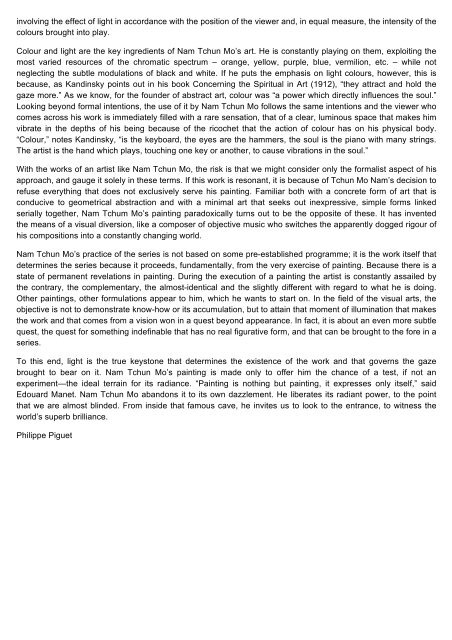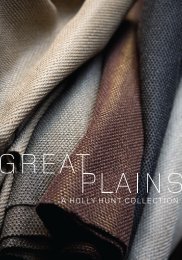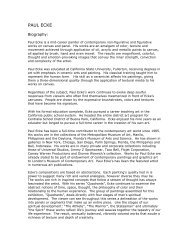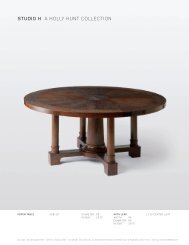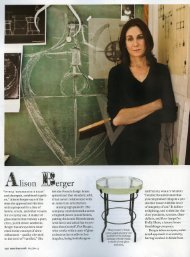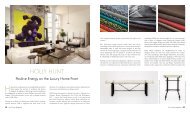Philippe Piguet on Nam Tchun Mo - Holly Hunt
Philippe Piguet on Nam Tchun Mo - Holly Hunt
Philippe Piguet on Nam Tchun Mo - Holly Hunt
You also want an ePaper? Increase the reach of your titles
YUMPU automatically turns print PDFs into web optimized ePapers that Google loves.
involving the effect of light in accordance with the positi<strong>on</strong> of the viewer and, in equal measure, the intensity of the<br />
colours brought into play.<br />
Colour and light are the key ingredients of <strong>Nam</strong> <strong>Tchun</strong> <strong>Mo</strong>’s art. He is c<strong>on</strong>stantly playing <strong>on</strong> them, exploiting the<br />
most varied resources of the chromatic spectrum – orange, yellow, purple, blue, vermili<strong>on</strong>, etc. – while not<br />
neglecting the subtle modulati<strong>on</strong>s of black and white. If he puts the emphasis <strong>on</strong> light colours, however, this is<br />
because, as Kandinsky points out in his book C<strong>on</strong>cerning the Spiritual in Art (1912), “they attract and hold the<br />
gaze more.” As we know, for the founder of abstract art, colour was “a power which directly influences the soul.”<br />
Looking bey<strong>on</strong>d formal intenti<strong>on</strong>s, the use of it by <strong>Nam</strong> <strong>Tchun</strong> <strong>Mo</strong> follows the same intenti<strong>on</strong>s and the viewer who<br />
comes across his work is immediately filled with a rare sensati<strong>on</strong>, that of a clear, luminous space that makes him<br />
vibrate in the depths of his being because of the ricochet that the acti<strong>on</strong> of colour has <strong>on</strong> his physical body.<br />
“Colour,” notes Kandinsky, “is the keyboard, the eyes are the hammers, the soul is the piano with many strings.<br />
The artist is the hand which plays, touching <strong>on</strong>e key or another, to cause vibrati<strong>on</strong>s in the soul.”<br />
With the works of an artist like <strong>Nam</strong> <strong>Tchun</strong> <strong>Mo</strong>, the risk is that we might c<strong>on</strong>sider <strong>on</strong>ly the formalist aspect of his<br />
approach, and gauge it solely in these terms. If this work is res<strong>on</strong>ant, it is because of <strong>Tchun</strong> <strong>Mo</strong> <strong>Nam</strong>’s decisi<strong>on</strong> to<br />
refuse everything that does not exclusively serve his painting. Familiar both with a c<strong>on</strong>crete form of art that is<br />
c<strong>on</strong>ducive to geometrical abstracti<strong>on</strong> and with a minimal art that seeks out inexpressive, simple forms linked<br />
serially together, <strong>Nam</strong> Tchum <strong>Mo</strong>’s painting paradoxically turns out to be the opposite of these. It has invented<br />
the means of a visual diversi<strong>on</strong>, like a composer of objective music who switches the apparently dogged rigour of<br />
his compositi<strong>on</strong>s into a c<strong>on</strong>stantly changing world.<br />
<strong>Nam</strong> <strong>Tchun</strong> <strong>Mo</strong>’s practice of the series is not based <strong>on</strong> some pre-established programme; it is the work itself that<br />
determines the series because it proceeds, fundamentally, from the very exercise of painting. Because there is a<br />
state of permanent revelati<strong>on</strong>s in painting. During the executi<strong>on</strong> of a painting the artist is c<strong>on</strong>stantly assailed by<br />
the c<strong>on</strong>trary, the complementary, the almost-identical and the slightly different with regard to what he is doing.<br />
Other paintings, other formulati<strong>on</strong>s appear to him, which he wants to start <strong>on</strong>. In the field of the visual arts, the<br />
objective is not to dem<strong>on</strong>strate know-how or its accumulati<strong>on</strong>, but to attain that moment of illuminati<strong>on</strong> that makes<br />
the work and that comes from a visi<strong>on</strong> w<strong>on</strong> in a quest bey<strong>on</strong>d appearance. In fact, it is about an even more subtle<br />
quest, the quest for something indefinable that has no real figurative form, and that can be brought to the fore in a<br />
series.<br />
To this end, light is the true keyst<strong>on</strong>e that determines the existence of the work and that governs the gaze<br />
brought to bear <strong>on</strong> it. <strong>Nam</strong> <strong>Tchun</strong> <strong>Mo</strong>’s painting is made <strong>on</strong>ly to offer him the chance of a test, if not an<br />
experiment—the ideal terrain for its radiance. “Painting is nothing but painting, it expresses <strong>on</strong>ly itself,” said<br />
Edouard Manet. <strong>Nam</strong> <strong>Tchun</strong> <strong>Mo</strong> aband<strong>on</strong>s it to its own dazzlement. He liberates its radiant power, to the point<br />
that we are almost blinded. From inside that famous cave, he invites us to look to the entrance, to witness the<br />
world’s superb brilliance.<br />
<str<strong>on</strong>g>Philippe</str<strong>on</strong>g> <str<strong>on</strong>g>Piguet</str<strong>on</strong>g>


